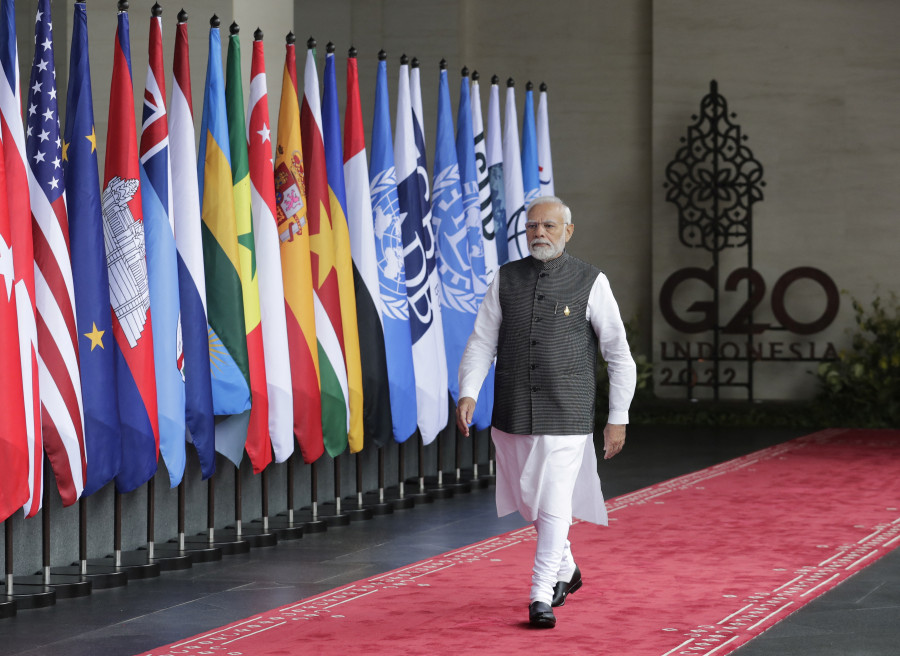Columns
Regional integration amid India’s G-20 presidency
A united South Asia can help boost development and growth for all countries involved.
Bigyan Babu Regmi & Sisir Bhandari
The tremendous need for regional integration in South Asia persists. Historical disputes, cultural diversity, political tensions and ineffective plurilateral arrangements have impeded the regional cooperation that is long overdue. According to the World Integrated Trade Solutions, intraregional trade in South Asia accounts for merely 7 percent of the region's total trade, compared to 50 percent in East Asia and the Pacific, 25 percent in Sub-Saharan Africa, and 16 percent in the Middle East and North Africa. Similarly, the legacy of political tensions based on historical disputes has deteriorated trust and the notion of solidarity, leading to less people-to-people contact.
With empirical evidence on the economic and political cases for interconnectedness made by the World Bank, Asian Development Bank and think tanks, there ought to be colossal development dividends—beyond (inclusive of) trade and economic gains—that can be reaped by unlocking the integration bottlenecks in South Asia. This year, as India leads the G20 and accentuates its increasing economic power, it should also be an apt time to inspire regional cooperation. India has a unique opportunity to consolidate South Asia's integrity, growth, and governance with enhanced collaboration. The region can harness its G20 lead to leverage attention by investing in infrastructure, fostering energy partnerships, and boosting regional economic cooperation.
‘Vasudhaiva Kutumbakam’
India conveys its conviction towards unity and shared prosperity through its G20 theme of Vasudhaiva Kutumbakam—the Vedic Sanskrit prose meaning the world is one family. Yet, when it comes to collective growth in the region, the realisation that a united South Asia can better capture global economic opportunities and augment growth trajectories for each country seems sparse.
In a region with a population exceeding 2 billion and a robust $4.1 trillion economy, India has firmly established itself among the booming economies of the 21st century, with 1.4 billion people and a $3.4 trillion economy. By 2035, India will be the third-largest economy, followed by Bangladesh as one to watch. However, South Asia only accounts for $23 billion in trade flow today, well below the estimated potential of $67 billion. Against this backdrop, as the leaders from the G20 nations convene in Delhi this September, it might be an opportune moment to negotiate as an emerging South Asia, capture spillovers beyond the Indian borders, and polish agendas for long-term regional integration on its thrust.
In the next five years, India expects more than $450 billion in foreign direct investments, mainly from G20 economies, to support its ambitions towards economic reforms, promote capital market investments, and formulate more liberal trade policies. There will be investment spillovers in the region from which the neighbouring economies can benefit. However, it is necessary to strategise the economic opportunities that other countries can draw.
First, each country should be able to identify its development needs and prioritise prudent economic policies—learning from the sovereign debt crisis of Sri Lanka and Pakistan. Second, there should be a consensus on regional projects, infrastructure, and cross-border initiatives that can make one economy in the region more accessible to the other. Making a case for such a two-layered development agenda, India should amplify the potential of the vast economic resources and production factors South Asia offers.
Partnership on climate and energy
The industrial economic growth model is dominant in South Asia, where the concepts of green energy and green economy are nascent. As a result, it is home to eight of the 10 most polluted cities in the world, which are also the region's economic powerhouses. Fossil fuel energy remains the dominant cause of environmental degradation. As of 2022, fuel import account for 29 percent of total merchandise imports in South Asia, where India is the second largest producer and consumer of coal globally. Large economies such as India and Bangladesh must import clean energy from neighbouring countries with high renewable energy potential, such as Nepal, to change this tide.
However, infrastructural gaps in energy production, storage, and transmission prevail, which is an area that needs regional and global investments. Furthermore, innovation in alternative energy sources in South Asia will be vital in meeting growing energy needs in the long term. It is imperative that India, leveraging its G20 leadership, projects its ambition on green energy and calls for global support on capital and technology.
South Asia is home to the world's tallest Himalayan range and is highly vulnerable to climate change. Climate change-induced disasters such as flooding, droughts, and desertification have affected over half of all South Asians in the last two decades. The frequency of disasters is escalating, underscoring the pressing need to mitigate the effects of climate change in the region. Despite the urgency, political tensions between countries and the lack of trust in mutual development initiatives have hindered consensus-building and collective action on climate change. India's G20 presidency offers the objective and transformative platform to build regional synergy and grab global attention on climate change in the Hindu Kush Himalayan region.
Juvenile demographics
South Asia is home to more youngsters—roughly around 1.8 billion people below the age of 24—than any other region globally. Although ebbing in recent decades, the fertility rate in South Asia is higher than that of the global average. As such, the working-age population continues to increase, and creating a near-equivalent number of jobs is a challenge now and in the future.
As economies such as India and Bangladesh grow rapidly, they can absorb a large labour force into the domestic market. However, in the long run, if other countries in the region lag behind and face unemployment issues, even the economies that have salient growth might see negative externalities and spillovers. To this end, developing regional policy tools to unlock growth and employment opportunities in the region would expand the pie. Establishing robust channels for private sector engagement, labour, and capital mobility will pave the path toward creating decent jobs.
On the other hand, innovation, as it stands, transcends borders. Enabling seamless collaboration and fellowship among youth, entrepreneurs, and researchers in the region could allow South Asia to be at the forefront of Industry 6.0 and beyond. With a rising digitally literate, tech-savvy working population, India and Bangladesh are already tapping into the business process outsourcing (BPO) industry by generating revenue of over $5 billion and $700 million, respectively. A collective approach to harnessing tech-related economic activities can enable further cost-optimisation, cross-border growth of BPO companies, and the offering of more diverse products.
Conclusion
India's G20 presidency brings immense opportunities for South Asia to address economic challenges, foster regional cooperation in climate and energy, and lead innovation based on favourable demographics. However, to better capture the economic opportunities that this occurrence propels, it is in the interest of India and countries in South Asia to accelerate cooperation and move toward regional integrity.
By leveraging its leadership role, India can advocate for the interests of South Asia and contribute to the region's overall growth and development while shaping the global agenda on crucial issues. As India aims for global leadership, it is vital to first lead its region by prioritising South Asia, bridging gaps, bringing opportunities, and harnessing its potential to create a mutually inclusive and sustainable future for all.




 12.12°C Kathmandu
12.12°C Kathmandu
















